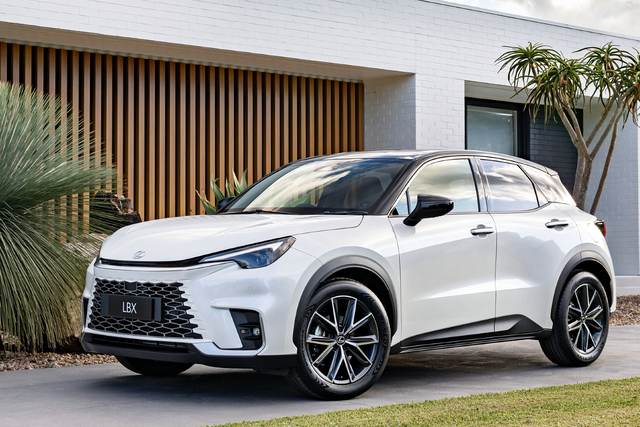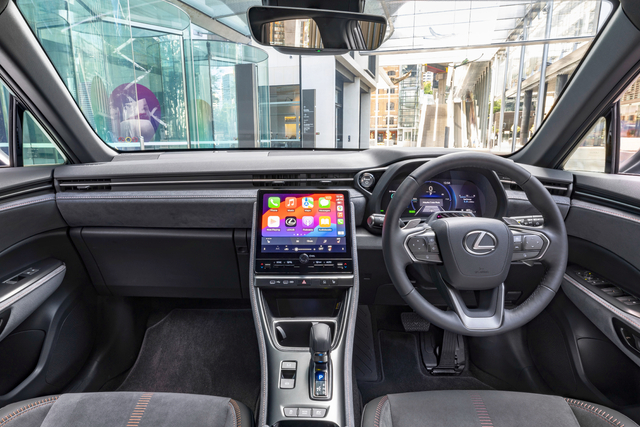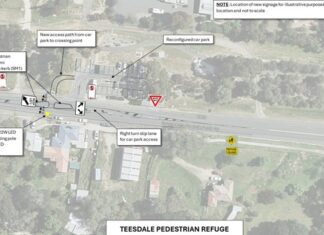LBX is the Lexus equivalent of the Toyota Yaris Cross, but is it more than that?
With a truncated, low-riding version of the Lexus ‘spindle’ grille, the letters apparently stand for ‘Lexus Breakthrough X(cross)-over’.
It’s a Lexus, yes and a crossover, but we’re not sure what makes it a breakthrough.
Sitting below the UX, it is the smallest Lexus to date and only the second model to carry a three-letter name, instead of the usual two letters, after the halo LFA supercar from 2011.
L was reportedly added to the combination to avoid a clash with Citroen which owns the rights to BX, a model the French marque produced from 1982 to 1994 – when it was replaced by the Xantia.
STYLING
There are three grades from which to choose, with prices starting from $47,550 plus on-roads for the LBX Luxury 2WD, $52,990 for LBX Sports Luxury 2WD or $56,990 for LBX Sports Luxury AWD.
Our test vehicle was the entry level Luxury grade finished in pearlescent white.
It can be identified by 18-inch alloy wheels with a dark grey and bright machined finish, LED headlights with adaptive high beam, rear spoiler and privacy glass and a two-tone finish.
Inside, the LBX Luxury has black NuLuxe upholstery for the seats, steering wheel, door and instrument panel trim, with contrasting red stitching, front and rear carpet floor mats, heated front seats, two-zone climate air with remote function, wireless phone charging, auto-dimming rear-view mirror, ambient interior lighting, smart entry and start and a powered tailgate.
The front seats are heated with eight-way power adjustment for the driver with two-way lumbar support and memory function.
Sports Luxury adds unique 18-inch wheels and a unique finish on the rear pillar which combines thin strips of gloss and non-gloss finish to create a stylish geometric expression.
Inside, it gains a combination of artificial NuLuxe and Ultrasuede upholstery, suede cloth trim for the door, instrument panel, and console box, and a premium leather shift knob and heated steering wheel.
The higher grade also gains Head-Up Display (HUD) with touch-sensitive steering wheel controls, multi-colour ambient interior lighting and a 13-speaker Mark Levinson audio and active noise control.
Lexus Teammate advanced park is also included to make parking even easier.
LBX comes standard with a five-year/unlimited kilometre warranty, plus a three-year complimentary subscription to Lexus Encore which provides exclusive offers with luxury hotel partners, invites to events and experiences and fuel discounts at participating Ampol servos.
INFOTAINMENT
Multimedia is supported by a 9.8-inch touchscreen display with satellite navigation, paired with a six-speaker Panasonic audio system compatible with wireless Apple CarPlay and wireless Android Auto.
Up to three users can save their personal settings for the multimedia, vehicle settings and active safety parameters.
There’s wireless charging, three front and two rear USB-C ports, as well as front and rear 12V accessory sockets.
But bear in mind the charge sockets are USB-C, so that old USB-A to -C cable is not going to work.
ENGINES/TRANSMISSIONS
The hybrid system in front-drive LBX combines a 1.5-litre three-cylinder, Atkinson Cycle petrol engine that produces 69kW/185Nm, with a single electric motor that generates a combined output of 100kW.
In comparison, the donor Yaris Cross has a smaller electric motor and delivers 67kW/120Nm, with a peak output of 85kW.
A CVT-style continuously variable auto offers two modes: Eco and Normal.
SAFETY
As yet the LBX has not been rated for safety by ANCAP.
Lexus Safety System+ provides a comprehensive suite of safety features, including eight airbags, which is designed to help provide protection for drivers, passengers, and other road users.
It’s equipped with the Pre-Collision System (PCS) with Pre-collision Braking (PB), which may be able to detect preceding vehicles, pedestrians and bicyclists in the daytime, as well as oncoming vehicles and motorcycles in the daytime.
A camera mounted on the steering column monitors driver attention.
If, like me, you often drive one-handed, with that hand in the 12 o’clock position, you’ll get in trouble from the system because the camera cannot see your face.
We kid you not. The system may even shut down the car if it becomes really concerned.
DRIVING
We didn’t get off to a good start with the LBX.
Although the key was in the cabin, it somehow managed to lock itself. Good thing there’s a secret button that can be used to release the doors.
After that hiccup LBX refused to start, as in the electrical system played totally dead – no lights, no nothing.
After jumpering the car, it was finally coaxed into life, but then did the exact same thing a couple of days later.
Grrr . . .
It may have been a failing 12-volt battery, but deciding to take no chances we treated the LBX as a plug-in hybrid, connecting it to a trickle charger each time we returned home.
While the 12-volt battery is located under the back seat like my old Beetle, it is possible to charge the car from the fuse box under the bonnet.
Thankfully, there were no further recurrences.
Although the car reports the current state of the hybrid system, the instrumentation does not extend to a monitor for the secondary battery as it has done in many other cars over the years.
The project lead engineer Kunihiko Endo said engineering the car to provide the level of refinement expected from a Lexus was a challenge.
Being a smaller vehicle space was limited and they had to adopt a different approach to the traditional use of sound insulation.
Does it work? Yes and no.
Back in the day, the V8-powered Lexus LS 400 was the quietest car we had ever driven.
It was so quiet that it was often difficult to tell whether the engine was running and we kept double-starting it.
Fast forward and the LBX is not that car.
You cannot escape the fact that this is a small vehicle with a short wheelbase, and the ride tends to be choppy on our second rate roads.
Engine noise is also very apparent under hard acceleration.
The front suspension features a new MacPherson strut setup with updated geometry to ensure straight-line stability and minimal understeer.
At the rear, front-drive variants use a rigid torsion beam while the AWD variant employs a trailing arm, double wishbone set-up to accommodate the rear motor.
The chassis has been strengthened with multiple braces, short pitch welding techniques and more than 19 metres of structural adhesive to maximise torsional rigidity.
The bonnet meanwhile is made of aluminium to save weight.
The dash from 0-100km/h takes 9.2 seconds and it has a top speed of 170km/h.
Combined fuel consumption from the 36-litre tank is a claimed 3.8L/100km, using standard 91 RON unleaded, with CO2 emissions of 85g/km.
LBX features a bi-polar nickel-metal hydride battery, which Lexus reckons offers much greater power density and throughput potential than traditional lithium-ion cells.
The nickel-metal hydride battery is positioned underneath the rear seat.
Aside from electrical problems, LBX feels like a definite step up from Yaris Cross.
The drive experience is generally satisfying, but performance is adequate rather than exhilarating.
The leather-accented steering wheel is among the best we’ve used, smooth, chunky and easy on the fingers.
Fuel consumption is good, but higher than expected, at 4.9L/100km after 420km, compared to the manufacturer’s claim of 3.8L/100km.
Two Isofix child seat anchors are offered in the rear, but rear legroom is pretty much non-existent.
The boot however has a larger capacity than expected.
A puncture repair kit is provided in lieu of a spare tyre and wheel.
Of note the infotainment system needs a bit of work.
There’s no home button and no facility to connect to Android Auto if your phone does not automatically re-establish a connection upon re-entering the vehicle.
We found the overhead 360 degree camera so annoying that we opted to turn it off.
As soon as vehicle speed drops to a crawl, it switches on obscuring the map or whatever else is on screen.
Grrr . . .
The satnav is second rate, offering very little information in regard to street signs and upcoming turns.
We switched to Waze instead.
Grrr . . .
SUMMING UP
Sorry, but that’s a no from us.
LBX is too small and has too many annoying traits.
In fact, apart from growing its market share, we’re left wondering whether models like the UX and LBX risk eroding the reputation that Lexus has battled to build over the past 30 years or so.
Then again younger drivers recognise and find the styling appealing, so maybe we are just not part of the demographic that Lexus has in its sights.
RATINGS:
Looks: 7.5
Performance: 7
Safety: 8
Thirst: 7.5
Practicality: 7
Comfort: 7
Tech: 7.5
Value: 7.5
Overall: 7.4









